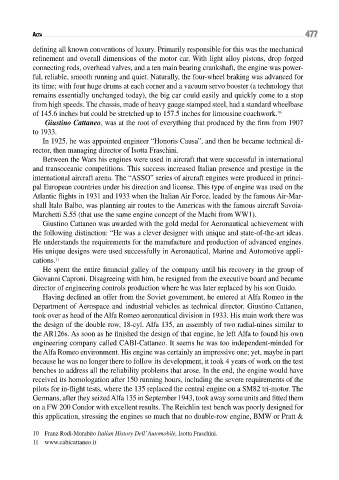Page 477 - Conflitti Militari e Popolazioni Civili - Tomo I
P. 477
477
aCta
defining all known conventions of luxury. Primarily responsible for this was the mechanical
refinement and overall dimensions of the motor car. With light alloy pistons, drop forged
connecting rods, overhead valves, and a ten main bearing crankshaft, the engine was power-
ful, reliable, smooth running and quiet. Naturally, the four-wheel braking was advanced for
its time; with four huge drums at each corner and a vacuum servo booster (a technology that
remains essentially unchanged today), the big car could easily and quickly come to a stop
from high speeds. The chassis, made of heavy gauge stamped steel, had a standard wheelbase
of 145.6 inches but could be stretched up to 157.5 inches for limousine coachwork. 10
Giustino Cattaneo, was at the root of everything that produced by the firm from 1907
to 1933.
In 1925, he was appointed engineer “Honoris Causa”, and then he became technical di-
rector, then managing director of Isotta Fraschini.
Between the Wars his engines were used in aircraft that were successful in international
and transoceanic competitions. this success increased italian presence and prestige in the
international aircraft arena. The “ASSO” series of aircraft engines were produced in princi-
pal European countries under his direction and license. This type of engine was used on the
Atlantic flights in 1931 and 1933 when the Italian Air Force, leaded by the famous Air-Mar-
shall Italo Balbo, was planning air routes to the Americas with the famous aircraft Savoia-
Marchetti S.55 (that use the same engine concept of the Machi from WW1).
Giustino Cattaneo was awarded with the gold medal for Aeronautical achievement with
the following distinction: “He was a clever designer with unique and state-of-the-art ideas.
He understands the requirements for the manufacture and production of advanced engines.
His unique designs were used successfully in Aeronautical, Marine and Automotive appli-
cations. 11
He spent the entire financial galley of the company until his recovery in the group of
Giovanni Caproni. Disagreeing with him, he resigned from the executive board and became
director of engineering controls production where he was later replaced by his son Guido.
Having declined an offer from the Soviet government, he entered at Alfa Romeo in the
Department of Aerospace and industrial vehicles as technical director. Giustino Cattaneo,
took over as head of the Alfa Romeo aeronautical division in 1933. His main work there was
the design of the double row, 18-cyl. Alfa 135, an assembly of two radial-nines similar to
the AR126s. As soon as he finished the design of that engine, he left Alfa to found his own
engineering company called CABI-Cattaneo. It seems he was too independent-minded for
the Alfa Romeo environment. His engine was certainly an impressive one; yet, maybe in part
because he was no longer there to follow its development, it took 4 years of work on the test
benches to address all the reliability problems that arose. In the end, the engine would have
received its homologation after 150 running hours, including the severe requirements of the
pilots for in-flight tests, where the 135 replaced the central engine on a SM82 tri-motor. The
Germans, after they seized Alfa 135 in September 1943, took away some units and fitted them
on a FW 200 Condor with excellent results. The Reichlin test bench was poorly designed for
this application, stressing the engines so much that no double-row engine, BMW or Pratt &
10 Franz Rodi-Morabito Italian History Dell’ Automobile, isotta Fraschini.
11 www.cabicattaneo.it

